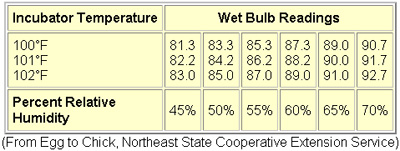

(2000) an increase of 1✬ (38.8✬) above the optimum incubation temperature (37.8✬) starting at day 13 of incubation causes a significant reduction of the hatching rate of broiler eggs, whereas such effect is not observed when the temperature is reduced in 1✬ (36.8✬). However, such effects depend on how long and how intense is the shift from optimum temperature. The effect of incubation temperature on egg hatchability and hatchling quality may be related to its influence on incubation length and water loss during incubation. The optimum incubation temperature of wild fowl eggs is within a wide range of values, varying from 33✬ to 39✬, whereas a narrower range (37✬ to 38✬) is considered as optimum for domestic poultry (Visschedijk, 1991). Therefore, it is essential to determine and use a temperature that promotes the highest hatchability (Swann & Brake, 1990b French, 1997) and the best hatchling quality (Wilson, 1991 Decuypere & Mitchels, 1992), known as optimum incubation temperature. Temperature is one of the physical factors that determine the success of incubation. Keywords: Incubation, hatchability, mortality, temperature, water loss. Nakage ES Cardozo JP Pereira GT Queiroz SA Boleli ICįaculdade de Ciências Agrárias e Veterinárias UNESP- Jaboticabal Incubation hatchability mortality temperature water lossĮffect of temperature on incubation period, embryonic mortality, hatch rate, egg water loss and partridge chick weight ( Rhynchotus rufescens) Our results show that, under conditions of daily incubation of eggs in the same incubator, higher hatching rate can be obtained using temperatures between 35.5✬ and 36.5✬ incubation temperature is inversely proportional to incubation length, and absolute and relative weights of partridge chicks are not affected by incubation temperature. Early embryonic mortality increased at low temperatures (36.5✬). There was no difference among incubation temperatures in absolute and relative hatchling weights. Water loss was lower in eggs incubated at low temperatures as compared to high temperatures. Incubation length and temperature were inversely proportional. The highest hatching percentage was obtained between 35.5 and 36.5✬. The aim of this study was to determine the effects of incubation temperature (34.5 35.5 36.5 37.5 and 38.5✬), on incubation period, embryonic mortality, hatching rate, water loss and chick weight at hatch, using daily incubation of partridge (Rhynchotus rufescens) eggs.


 0 kommentar(er)
0 kommentar(er)
